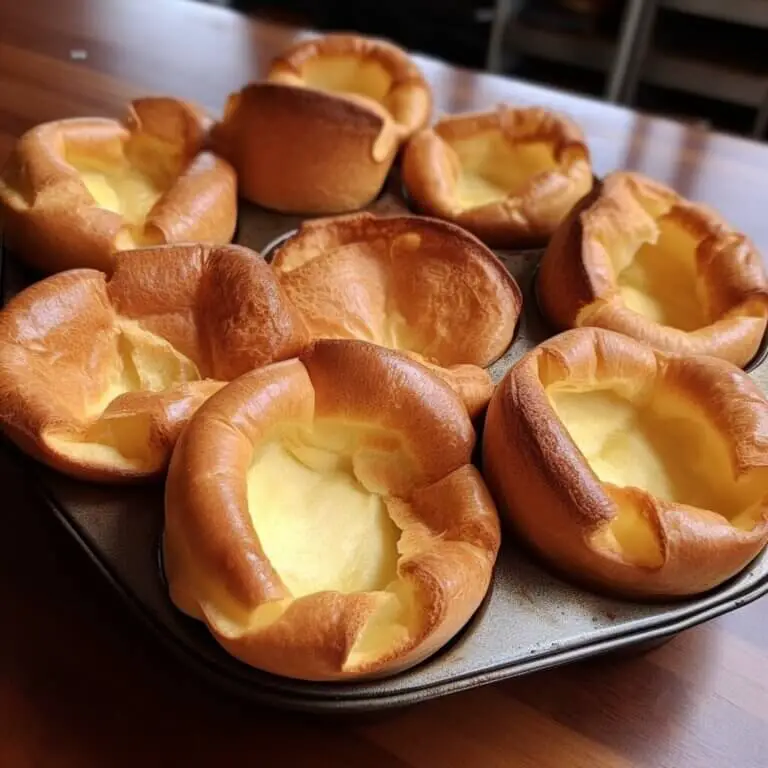Creating flawless Yorkshire puddings is nothing short of an art form. When done right, they rise majestically in the oven, their golden-brown peaks crisp and cloud-like, encasing a light, airy interior. The contrast of textures – crispy outside, tender inside – is what makes these classic British delights truly magical.
But let me tell you, my journey to Yorkshire pudding perfection was far from smooth. When I first attempted to recreate the puddings from my childhood Sunday roasts, the results were… let’s just say, underwhelming. Instead of tall, puffed-up beauties, my early attempts were flat, soggy, and lacked that essential crispiness.
What Went Wrong?
It took countless trials and plenty of errors to crack the code for consistently amazing Yorkshire puddings. Along the way, I learned that every detail matters – from the temperature of the oven to the consistency of the batter. Here are a few golden rules I discovered:
- Preheat to Perfection: Your oven and pan must be blazing hot.
- Chill the Batter: A well-rested, chilled batter leads to better results.
- No Peeking!: Resist the urge to open the oven door during baking.
Today, I can confidently say I’ve mastered the method. Every time I pull a tray of Yorkshire puddings from the oven, I still get a thrill as I watch those golden domes rise impossibly high.
Beyond Sunday Roasts
While traditionally served as the perfect accompaniment to roast beef, Yorkshire puddings are versatile. At breakfast, try topping them with jam or maple syrup for a delightful twist. The contrast of their crispy shell, soft interior, and the sweet burst of toppings is simply irresistible.
Your Guide to Yorkshire Pudding Glory
Now, I’m excited to share everything I’ve learned. From mixing the batter to ensuring your oil is sizzling hot before pouring, I’ll guide you step by step. Follow my recipe and tips, and you’ll soon be baking Yorkshire puddings that rival those of any bakery. Expect crisp edges, lofty heights, and that heavenly lightness in every bite.
Ready to elevate your pudding game? Grab your mixing bowl, preheat your oven, and let’s get started! Yorkshire pudding perfection is just a bake away.
What type of flour works best?
For the lightest, fluffiest Yorkshire puddings, all-purpose flour is ideal. Its lower protein content creates a delicate, airy interior, unlike bread or whole wheat flours, which can make the puddings denser.
2. Should eggs be at room temperature?
Absolutely. Room-temperature eggs blend smoothly into the batter, ensuring a better rise. Cold eggs can disrupt the texture and reduce puffiness.
3. What fat produces the best flavor and texture?
- Beef drippings provide a rich, savory flavor that’s hard to beat.
- Vegetable oil results in lighter puddings.
- Lard or goose fat are also excellent options, delivering crisp, golden edges.
4. Does resting the batter improve the results?
Yes! Resting the thin batter in the fridge for at least 30 minutes allows gluten to relax, leading to higher, fluffier puddings when baked.
5. Should the oven and fat be sizzling hot?
A resounding yes! Preheat both your oven and pan to 450°F or higher. Hot fat ensures the batter sizzles instantly, creating the signature puff and crispy texture.
6. Why shouldn’t I peek while they bake?
Avoid opening the oven door during baking. The sudden drop in temperature can cause your Yorkshire puddings to collapse before they’re fully set.
7. How do I achieve perfectly crispy edges?
Place your pan on the top oven rack for optimal heat circulation, and make sure the pan isn’t overcrowded. This allows the edges to crisp up beautifully while the puddings rise sky-high.
Follow these expert tips, and you’ll be serving flawless, golden Yorkshire puddings every time – crisp, airy, and irresistibly delicious!
Prep Time: 5 minutes
Cook Time: 25 minutes
Total Time: 30 minutes
Ingredients:
- 1 cup all-purpose flour (sifted)
- 1⁄4 teaspoon salt
- 3 large eggs (room temperature)
- 1 1⁄4 cups whole milk (cold)
- 1⁄3 cup beef drippings, vegetable oil, or lard
Instructions:
- Prepare Your Ingredients:
Gather all your essentials before you begin. Measure 1 cup of sifted flour, 1⁄4 teaspoon salt, 3 room-temperature eggs, 1 1⁄4 cups cold whole milk, and 1⁄3 cup of your chosen fat (beef drippings, vegetable oil, or lard). Pre-measuring ensures a smooth process, key for perfect Yorkshire puddings. - Chill for Success:
Place a 12-cup muffin tin and a large mixing bowl in the refrigerator for 10–15 minutes. A chilled tin and bowl help the batter stay cold and create a dramatic rise during baking. - Mix the Dry Ingredients:
In your chilled mixing bowl, combine the sifted flour and salt. Use a whisk to thoroughly blend, ensuring no clumps remain. - Incorporate Wet Ingredients:
Form a well in the center of the dry ingredients. Crack in the eggs one at a time, whisking gently. Slowly pour in the cold milk, whisking continuously to combine. Gradually draw in the surrounding flour, creating a smooth, lump-free batter that lightly coats the back of a spoon. - Heat the Muffin Tin:
Remove the chilled tin from the fridge. Evenly distribute the fat among the cups—about 1 teaspoon per cup. Place the tin on the top oven rack and preheat it to 450°F (230°C). The fat should be sizzling hot before adding the batter. - Pour and Bake:
Carefully pour the batter into the hot tin, filling each cup about three-quarters full. Work quickly to preserve the heat. Place the tin back on the top oven rack and immediately close the oven door. Bake for 20 minutes without opening the oven. - Check and Finish Baking:
After 20 minutes, take a quick peek. If needed, bake for an additional 5 minutes to achieve golden, crispy peaks. - Serve Immediately:
Remove the tin from the oven and place it on a heat-safe surface. Gently coax the puddings out to maintain their puffed-up shape. Serve hot with roasts, gravy, or sweet toppings like jam for a delightful twist.
Cooking Tips for Perfect Yorkshire Puddings:
- Rest the Batter: Chill for at least 30 minutes to allow the gluten to relax, improving the rise.
- Use Hot Fat: Pour the batter into sizzling hot oil or drippings for that signature puff.
- No Peeking: Keep the oven door closed during baking to prevent deflation.
- Quick Removal: Remove puddings from the tin immediately after baking to maintain their height.
- Reuse Fat: Save the oil from your first batch for subsequent rounds.
Storage and Reheating:
Store leftovers in an airtight container and reheat in the oven for a crisp finish.
With these tips and techniques, you’ll master the art of Yorkshire puddings—crispy, golden, and impossibly airy!

